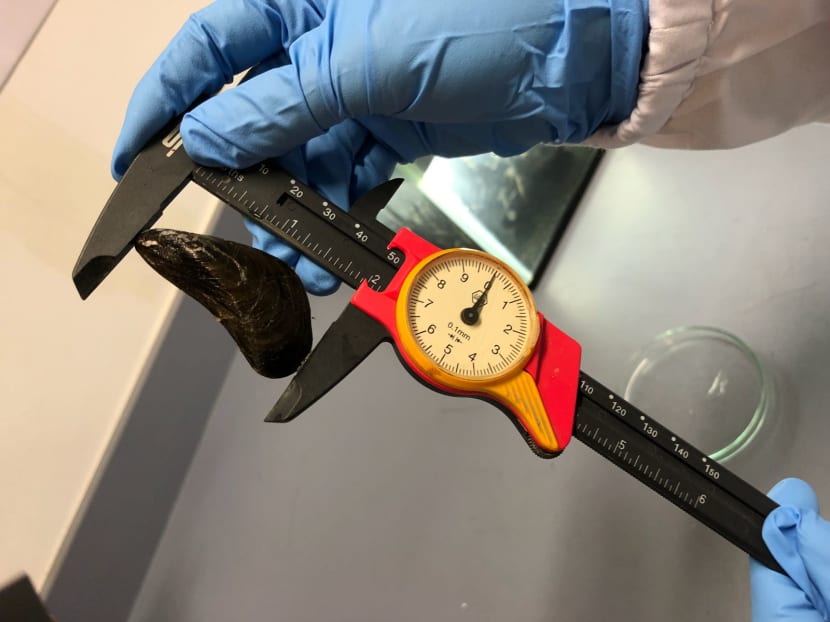Alien mussel species could hurt local fish farmers
SINGAPORE — An alien species of mussels spotted here since 2015 has raised alarm among environmental activists and could impact local fish farmers.

A researcher measures a Charru mussel, a non-native species which has been sighted at multiple locations here such as Sungei Buloh, Pasir Ris, Pulau Ubin and Sembawang Photo: Siau Ming En/TODAY
SINGAPORE — An alien species of mussels spotted here since 2015 has raised alarm among environmental activists and could impact local fish farmers.
Charru mussels, or Mytella strigata, are native to Central and South America. Closer to home, they were established in the Philippines in the 19th century.
The steady growth of the non-native mussels, which have been sighted at multiple locations here such as Sungei Buloh, Pasir Ris, Pulau Ubin and Sembawang, has led to concerns that they could out-compete native Asian green mussels and horseshoe crabs.
At least one fish farmer who also grows shellfish has been affected by the invasive mussels. Ah Hua Kelong co-owner Bryan Ang, 29, first noticed Charru mussels about two years ago at both his farms in Sembawang and Pasir Ris.
“They suddenly just appeared (and) kept growing till the green mussels cannot survive. It’s quite damaging,” he said.
Although not the main source of his business, his farms harvest about five tonnes of Asian green mussels a year. Now, Charru mussels make up about 70 to 80 per cent of his mussel harvest at the Sembawang farm, and about 25 per cent over at Pasir Ris.
“We can’t do anything about it. We can’t sell (the Charru mussels because) nobody is going to buy it, (they’re) so small. They (also) keep growing, like weed. You can clear them but they come back again,” he added.
Asian green mussels, which are bigger than Charru mussels, sell for S$8 per kg on Ah Hua Kelong’s website.
Some other fish farmers here grow Asian green mussels to filter harmful particles from the water around their farmed fish and do not sell the molluscs.
Mr Stephen Beng, chairman of the Nature Society Singapore’s marine conservation group, has seen a steady growth of the invasive mussels at the Kranji mudflats – home to horseshoe crabs – since late-2015.
The invasive species could out-compete the horseshoe crabs for space or strip the mudflats of life-supporting nutrients and cause a shift in the base of the food web, upsetting the ecosystem.
As an immediate response, Mr Beng and fellow volunteers plan to clear the non-native mussels that they find. In the longer term, they hope to conduct ecological studies to understand the interactions between the invasive and native species, he said.
Researchers here, who published a study on the Charru mussels last month, first discovered them on a routine field trip to the shores along the Johor straits in March 2016. It is the first time these mussels have been reported in the Malay Archipelago, said Dr Serena Teo, senior research fellow at the National University of Singapore’s Tropical Marine Science Institute.
The researchers have been studying mussels since September 2014 by placing nets underwater, which are inspected every month.
While it is not known how exactly the Charru mussels arrived at Singapore’s shores, they could have travelled via ballast water in ships or by aquaculture, said Dr Teo.
After the researchers’ first sighting of the Mytella strigata, they noticed the increase in their numbers, while that of the Asian green mussels – the only species previously found on the nets – fell. It meant the invasive species was reproducing much faster and occupying space on the nets, leaving no room for the Asian green mussels, said Dr Teo, who co-led the study.
To identify the new species, the researchers had to examine the interior surfaces of the shells, conduct genetic sequencing and examine museum specimens.
Their presence here could have various implications, said Dr Teo. “With this infestation, farmers may need to consider new ways to efficiently farm (Asian green mussels),” she said.
Besides causing drag in the movement of ships, the species may also find its way to other countries. In places with strict biosecurity laws, the presence of invasive pests can result in penalties for ship owners, she said.
And while Charru mussels can be eaten, Dr Teo cautioned against eating those collected in the wild as they may carry environmental contaminants.
The researchers plan to do further studies in areas such as the species’ growth rates, settlement patterns and how it interacts with other organisms in the ecosystem.
Invasive species are a concern worldwide because they have the potential to destroy biodiversity, alter habitats or cause native species to go extinct.
The Mytella strigata is not the only invasive mussel species here. Another, the Mytilopsis sallei, was introduced in the 1980s.
Other species non-native to Singapore that have found their way into the wild – possibly through the pet trade and abandonment by pet owners – include the Red-eared Slider (a turtle) and the Javan myna (which has become Singapore’s most abundant bird).









